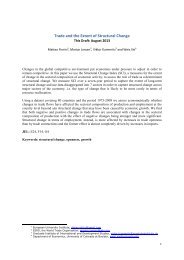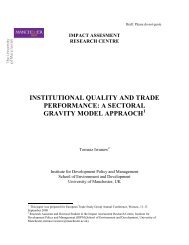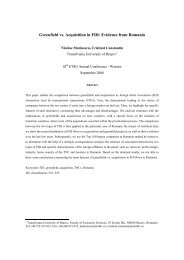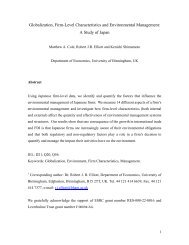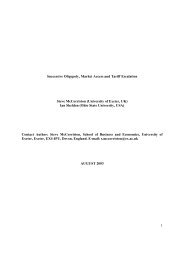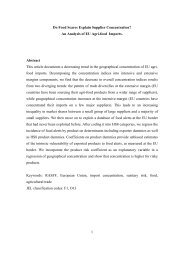Regional integration and the other determinants of North-South ...
Regional integration and the other determinants of North-South ...
Regional integration and the other determinants of North-South ...
You also want an ePaper? Increase the reach of your titles
YUMPU automatically turns print PDFs into web optimized ePapers that Google loves.
The pr<strong>of</strong>it <strong>of</strong> a single firm in c is thus given by:<br />
<br />
(3.5)<br />
The equilibrium can be derived as follows: expenditure on industry output<br />
produced in c, comes from producers <strong>and</strong> consumers located in c <strong>and</strong> from o<strong>the</strong>r countries l.<br />
The product market equilibrium requires setting dem<strong>and</strong> equal to supply. Summing <strong>the</strong><br />
expenditures <strong>of</strong> across all locations, we obtain:<br />
<br />
<br />
∑ <br />
(3.6)<br />
With ( <strong>the</strong> price in c <strong>and</strong> , <strong>the</strong> price index in country . Substituting <strong>the</strong><br />
product market clearing condition <strong>and</strong>, <strong>the</strong> pr<strong>of</strong>it maximizing price into <strong>the</strong> dem<strong>and</strong> gives:<br />
<br />
<br />
<br />
<br />
∑ <br />
<br />
(3.7)<br />
<br />
Since capital is used only in <strong>the</strong> fixed cost, <strong>the</strong> reward to capital is <strong>the</strong> operating pr<strong>of</strong>it<br />
<strong>of</strong> a typical variety, using <strong>the</strong> dem<strong>and</strong> function <strong>and</strong> mill pricing we obtain:<br />
<br />
<br />
∑ <br />
<br />
<br />
<br />
<br />
<br />
(3.8)<br />
As we do not observe <strong>the</strong> potential pr<strong>of</strong>itability <strong>of</strong> each country, following Amiti <strong>and</strong><br />
Smarzynska Javorcik (2008), we rely upon <strong>the</strong> assumption that firms choose <strong>the</strong> country<br />
yielding <strong>the</strong> highest pr<strong>of</strong>it. In <strong>the</strong> model, agents are short-sighted <strong>and</strong> capital moves in search<br />
<strong>of</strong> <strong>the</strong> highest current nominal reward. Inter-country factor flows are governed by <strong>the</strong> ad hoc<br />
equation 31 :<br />
1 (3.9)<br />
<br />
<br />
c 32 .<br />
is country’s c industry share, which also represents <strong>the</strong> share <strong>of</strong> capital employed in<br />
In <strong>the</strong> long run, capital owners employ <strong>the</strong>ir capital wherever it earns <strong>the</strong> highest<br />
return. In this case, capital has no incentive to move <strong>and</strong> 0. The share <strong>of</strong> a representative<br />
industry country c is related to pr<strong>of</strong>it ( ):<br />
(3.10)<br />
For <strong>the</strong> empirical specification, following Amiti <strong>and</strong> Smarzynska Javorcik (2008), we<br />
assume that <strong>the</strong> function: . Thus, we obtain:<br />
31 Note that in <strong>the</strong> FCVL model pure pr<strong>of</strong>its are eliminated <strong>and</strong> capital rewards are equal to operating pr<strong>of</strong>its. In<br />
<strong>the</strong> long run <strong>the</strong> spatial allocation <strong>of</strong> capital takes time <strong>and</strong> hence, current operating pr<strong>of</strong>its might differ from <strong>the</strong><br />
average in <strong>the</strong> short run.<br />
32 Remember that capital is mobile between countries whereas capital owners are immobile. Capital is only<br />
employed in meeting <strong>the</strong> fixed costs <strong>of</strong> industrial firms. Physical capital can be separate from its owners <strong>and</strong> so,<br />
<strong>the</strong> country in which capital’s income is spent may differ from <strong>the</strong> country in which it is employed (Martin <strong>and</strong><br />
Rogers, 1995).<br />
11



